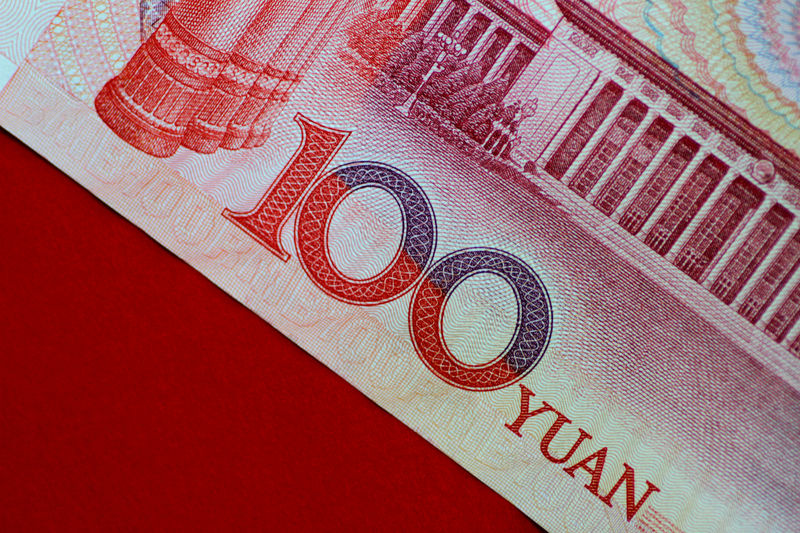 © Reuters. FILE PHOTO: Illustration photo of a China yuan note
© Reuters. FILE PHOTO: Illustration photo of a China yuan noteBy Winni Zhou and Kevin Yao
SHANGHAI/BEIJING (Reuters) – China’s ability to stabilize the yuan in recent weeks despite weak economic data and a further escalation in its trade war with the United States is reinforcing expectations that the central bank will cut banks’ reserve ratios again within weeks.
Such a move would underscore shifting policy priorities in Beijing, with growth promotion now on par with, if not trumping, a multi-year campaign to reduce leverage and risks in the financial system.
The People’s Bank of China (PBOC) has made three targeted cuts so far this year to bank reserve requirement ratios, or RRR, to free up more funds and encourage banks to continue to lend, particularly to smaller firms which are facing strains from the slowing economy.
Since the last cut was announced in late June, and the trade war escalated, the yuan skidded sharply against the dollar, dropping more than 6 percent.
(For a graphic on ‘China reserve requirement ratios and the yuan’ click https://reut.rs/2poDnZc)
But authorities finally stepped in in August to arrest the slide, tightening capital controls and making it more expensive for markets to bet against the currency.
The yuan
The PBOC will most likely cut RRR again this month or in October, according to a dozen economists, currency traders and policy advisers Reuters spoke with recently.
“We are likely to have a reduction in reserve requirement ratio by another 50 basis points (bps) in October,” said David Qu, a markets economist at ANZ in Shanghai.
Expectations vary between 50-100 bps worth of cuts by the end of the year.
“In general, deleveraging in the banking sector has come to an end. Commercial banks want to get stable and cheaper funds,” said Nie Wen, economist at Hwabao Trust in Shanghai.
China had already started adjusting fiscal and monetary policy before the U.S. trade frictions flared this spring, as rising borrowing costs and the crackdown on riskier lending weighed on investment and economic activity.
Beijing is accelerating approval of road and rail projects and is pumping liquidity into the system in various ways, which is reducing financing costs.
MORE AGGRESSIVE MEASURES NOT SEEN FOR NOW
For now, most analysts believe China will not resort to more forceful broad-based easing measures such as cut in its policy lending rate, which was last seen in late 2015.
While the world’s second-largest economy is clearly slowing, it has been largely resilient to U.S. trade pressure so far, and big construction projects will start to lend support next year.
The last across-the-board RRR was in February 2016. A similar move now would send a loosening signal that some believe the PBOC is not yet prepared to make, preferring to stick with what it calls “targeted” action, channeling funds to companies or rural areas which are seen as most vulnerable.
Still, with RRR at 15.5 percent for the country’s largest lenders, there is lots of wiggle room.
Larry Hu, head of greater China economics at Macquarie in Hong Kong, said “cutting RRR is like returning to normal, as China’s current RRR is way too high”. He expects a 50 bps reduction this month or October.
After successive RRR cuts in 2015 and early 2016, there was evidence that some of the funds were being used for speculative activity, such as bets on the property market, rather than for real economic activity.
Since then, the PBOC has updated its playbook, relying more on open market operations, and in particular the medium-term lending facility, or MLF, to support liquidity.
But analysts say the central bank is facing some of the same old problems, with a few big banks tending to hoard the injected funds and trade amongst themselves rather than allowing them to trickle down to smaller banks and small- and medium-size enterprises (SMEs).
Signs of slowing domestic demand in China and a rising number of debt defaults are adding to commercial banks’ caution this time around.
WATCH THE YUAN
“If we believe supporting SME funding is the current priority, I think RRR is the most efficient way to achieve that. But the yuan may face renewed depreciation pressure if China eased too much. So that’s the dilemma China needs to think about carefully,” said Tommy Xie, economist at OCBC Bank in Singapore.
The U.S. Federal Reserve is expected to raise interest rates again late next week, which could exacerbate pressure on China as the countries’ interest rate spreads shrink further.
China has at times made symbolic moves to follow the Fed and it is unclear if it will do so this time – even while it seems poised to cut RRR.
“The general idea of the central bank’s monetary policy implementation now is credit easing,” said ANZ’s Qu.
And authorities have plenty of other ways to keep a grip on the yuan without dipping into the country’s currency reserves as they did massively a few years ago.
China’s yuan exchange rate remains tightly managed, and big state-owned banks are often believed to be acting on behalf of the central bank.
Source: Investing.com




























